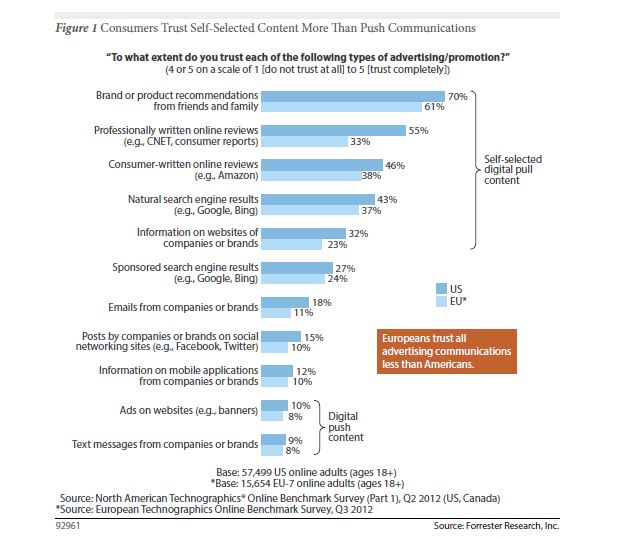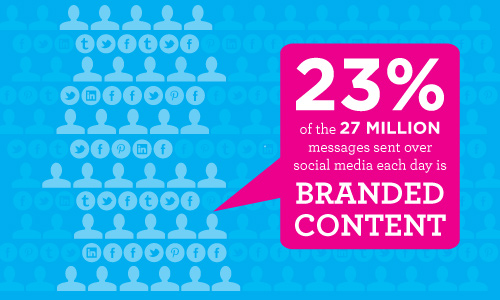The idea of “branded content” often conjures up images of expensive marketing campaigns with Hollywood-style treatments. So to a smaller business, the concept may feel daunting. But the reality is that branded content can run the gamut of scale and budget; the most important thing is to do it well. And for a small business, a well-thought campaign can utilize branded content to great effect.
In this post, you’ll learn:
-What’s the big deal about branded content?
-Where to begin your own branded content efforts
Why all the fuss about branded content?
As defined by the Branded Content Marketing Association through commissioned research, branded content is “any content that can be associated with a brand in the eye of the beholder.” In that light, branded content is obviously of the utmost importance as it encompasses the entirety of your marketing efforts, and beyond.
More specifically, “branded content” often refers to something purposefully created by a brand in order to entertain or educate its target audience. It is intended to create positive feelings about a company, product, or service without going in for the hard sell—and it is often designed to encourage and facilitate sharing. It may use images, characters, and storylines that are clever, surprising, or touching, which aim to win over the viewer or reader.
This more nuanced type of branded content may seem less traditional than a straightforward campaign with a “buy now!” punch line, or one that aims to tout a product’s superior attributes. But it still relies on age-old tenets of marketing and holds distinct powers of persuasion. By leveraging branded content’s softer-sell approach, a smaller company can build awareness, goodwill, and its customer base.
Where do I begin?
Myth: branded content has to be complicated. Not true; in fact, simpler is often better. Before you even start to think about what should be written, filmed, designed, or produced—take a minute to put yourself in the shoes of your customer or potential customer.
Ask: what type of information and education would be useful to your target audience? (Some answers may seem beyond the scope of your company’s knowledge base or expertise—but don’t discount these ideas off the bat; there may be something to them.)
Next, figure out your goal for the branded content campaign. Do you seek increased visitors to your homepage or social media pages? Increased awareness of your brand in the marketplace? More leads? Sign-ups for a free download or trial?
Once you determine the type of content that makes the most sense, and what you’d like readers/viewers to do as a result, think about what channel(s) would be most logical (keeping your budget in mind, of course). For instance, maybe your company has some relevant and compelling data that would lend itself to an infograph treatment. Or maybe a short video would help bring your customer’s needs to life.
Then, execute. And if you don’t have internal resources that can help to produce the branded content you want, look to outside firms who can work within your budget to provide something new and fresh that resonates with your target audience.
You may even want to partner with an organization or association to bring their content to your audience. Here’s a secret: you don’t have to create all of your branded content from scratch; instead, find clever, visual ways to repurpose existing information or leverage your company’s relationships to solicit shareable, relevant content.
Once you’ve launched your campaign, monitor and measure its results—and have a strategy in place to ensure that your campaign doesn’t get stale. If you get in the habit of regularly offering topical, helpful content to customers and prospects, your brand will start to become a trusted and ongoing resource for them.
Also, make sure you get the word out so your branded content can work best by linking other marketing functions to your content. You can push out teasers from social media, email campaigns, and other digital outlets that can then point back to your site or wherever the content lives. At times, you can push people to a landing page that is more targeted to the audience you are reaching, making your campaign more successful.
Tips and reminders
Forrestor Research reminds us that branded content “is designed to build brand consideration and affinity, not sell a product or service.” The good news is that customers generally trust and respond well to this type of content. Recent research from Vibrant Media showed that advertorials ranked higher as a useful source of information than journalist-written articles. And one in three respondents rated an advertiser’s own website as the most useful source of information about a product, with particular receptivity to content delivered in an image-based format.
As noted by Joe Palazzo, founder of the Content Marketing Institute, in 2012: “The future of the marketing department is half content and half publishing.” That future is now. The key is thinking smart about your branded-content campaign and leveraging resources beyond the four walls of your own company. And never lose sight of your audience and what sorts of information they need and want. So, start small, and you’ll go far! Smaller businesses can have just as much—or more—success with branded content as their larger peers. Good luck!
by Amy Zucchi-Justice, Co-Founder & Head of Marketing and Strategy, The Karlyn Group.
Amy Zucchi-Justice is an experienced marketer and sales professional specializing in media, events, product creation and launches—as well as creating successful growth-oriented branding campaigns.
